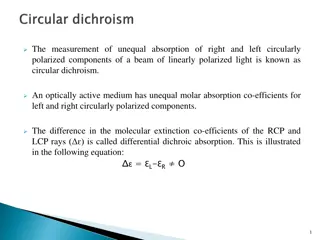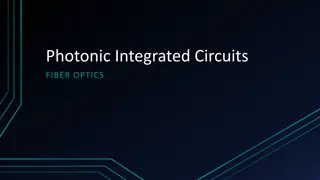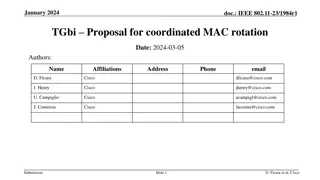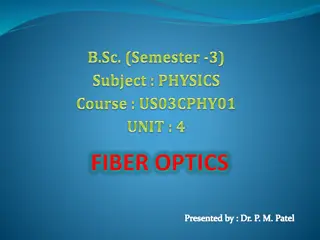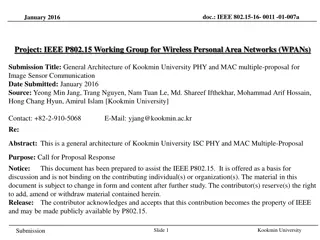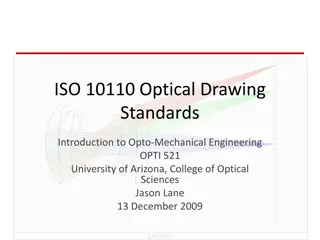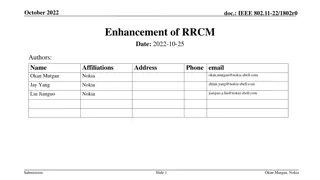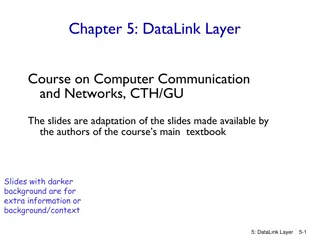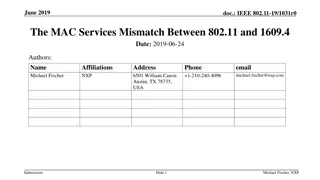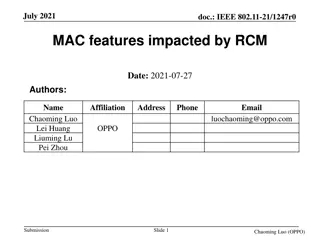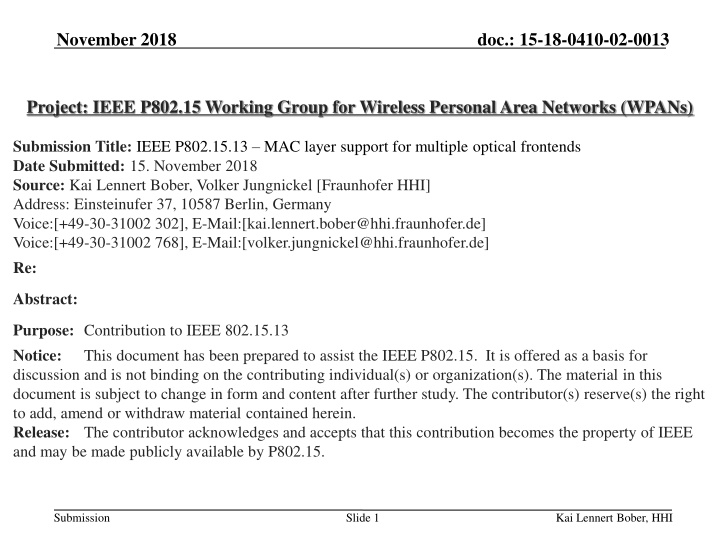
IEEE P802.15.13 MAC Layer Support for Optical Frontends Proposal
Proposal submission for IEEE P802.15.13 focusing on introducing protocol procedures and frame types to facilitate distributed optical frontends and MIMO techniques in a star topology. The document outlines the concept of virtual cells, spatial diversity on the signal level, smooth handover performance, and high quality of service with low-level soft handovers. It presents a superframe structure for spatial reuse and joint transmission/reception in a wireless personal area network environment.
Download Presentation

Please find below an Image/Link to download the presentation.
The content on the website is provided AS IS for your information and personal use only. It may not be sold, licensed, or shared on other websites without obtaining consent from the author. If you encounter any issues during the download, it is possible that the publisher has removed the file from their server.
You are allowed to download the files provided on this website for personal or commercial use, subject to the condition that they are used lawfully. All files are the property of their respective owners.
The content on the website is provided AS IS for your information and personal use only. It may not be sold, licensed, or shared on other websites without obtaining consent from the author.
E N D
Presentation Transcript
November 2018 doc.: 15-18-0410-02-0013 Project: IEEE P802.15 Working Group for Wireless Personal Area Networks (WPANs) Submission Title: IEEE P802.15.13 MAC layer support for multiple optical frontends Date Submitted: 15. November 2018 Source: Kai Lennert Bober, Volker Jungnickel [Fraunhofer HHI] Address: Einsteinufer 37, 10587 Berlin, Germany Voice:[+49-30-31002 302], E-Mail:[kai.lennert.bober@hhi.fraunhofer.de] Voice:[+49-30-31002 768], E-Mail:[volker.jungnickel@hhi.fraunhofer.de] Re: Abstract: Purpose: Contribution to IEEE 802.15.13 Notice: This document has been prepared to assist the IEEE P802.15. It is offered as a basis for discussion and is not binding on the contributing individual(s) or organization(s). The material in this document is subject to change in form and content after further study. The contributor(s) reserve(s) the right to add, amend or withdraw material contained herein. Release: The contributor acknowledges and accepts that this contribution becomes the property of IEEE and may be made publicly available by P802.15. Submission Slide 1 Kai Lennert Bober, HHI
November 2018 doc.: 15-18-0410-02-0013 IEEE P802.15.13 MAC Layer support for Multiple Optical Frontends Date: 2018-11-15 Place: Bangkok, Thailand Authors: Name Company Address Phone Email Kai Lennert Bober Volker Jungnickel Fraunhofer HHI Fraunhofer HHI kai.lennert.bober@hhi.fraunhofer.de volker.jungnickel@hhi.fraunhofer.de Submission Slide 2 Kai Lennert Bober, HHI
November 2018 doc.: 15-18-0410-02-0013 Content This doc. contains a proposal for protocol procedures and frame types, necessary to support distributed optical frontends and MIMO techniques in the star topology. Submission Slide 3 Kai Lennert Bober, HHI
November 2018 Descriptive: Targets of the Distributed Optical Frontend (OFE) Approach doc.: 15-18-0410-02-0013 Introduction of spatial diversity on the signal level Enable spatial reuse with smooth handover performance and high QoS Low level soft handover : OFE form virtual cells following the device s movement, fully transparent to the management protocol Coordinator Fronthaul Optical Frontend Device OWC signal Fig 1: Coordinator in star topology with distributed OFEs serving two devices simultaneously Submission Slide 4 Kai Lennert Bober, HHI
November 2018 Descriptive: Superframe Structure for Spatial Reuse and Joint Transmission + Reception Beacon doc.: 15-18-0410-02-0013 CAP CFP Slotted uplink random access without carrier sensing (ALOHA) in CAP. For association and reconnection only; collisions may occur. GTS allocations per device for regular collision-free transmission and in the CFP. Different GTS allocated in same superframe slot but different OFE slots (SDMA). GTS spans over multiple OFE slots, implying a virtual cell for joint transmission / reception. OFE slots = SPACE Receive A Receive B Receive C Receive D GTS = TIME + SPACE reservation Superframe slots = TIME Concept of superframe structure. Only receive (downlink) direction is considered for simplicity. A,B,C,D = devices. Submission Slide 5 Kai Lennert Bober, HHI
November 2018 Descriptive: Channel Estimation, CSI Feedback and GTS Update doc.: 15-18-0410-02-0013 Multicell channel estimation is based on multi-cell pilots in the beacon. For individual virtual cell transmissions, additional desired BAT or MCS feedback can be generated. The coordinator schedules GTS based on feedback and selects adaptive transmission. Dynamic GTSs are updated via control frames and valid during next superframe, if validity=0, otherwise for multiple superframes. Previous dynamic GTS allocations lose validity. GTS update is acknowledged in next feedback frame. scheduling channel est. BP CAP CFP Coordinator beacon feedback dynamic GTS Device control frame channel est. Multi-cell channel est. Submission Slide 6 Kai Lennert Bober, HHI
November 2018 doc.: 15-18-0410-02-0013 Multi-cell channel estimation feedback TAP format for the setting of variable resolutions for the taps Bits: 0-3 4-7 Variable Number of OFEs OFE TAP format descriptor 1 Symbol (1-7) + division (1-32) for pilot / OFE identification. Bits: 0-2 3-7 8-15 Variable Number of TAPs Symbol Division TAP descriptor 1 Bits: 0-7 ? 8-15 ? 16-23 ? Strength for first tap is SNR [dB]. For other TAPs it is the ratio [dB] between first and current TAP First OFE / TAP is the one with lowest delay. Integer delay Decimal delay Strength Submission Slide 7 Kai Lennert Bober, HHI
November 2018 doc.: 15-18-0410-02-0013 Adaptive bitloading feedback: requested BAT control frame format Valid BAT bitmap indicates applicability of each of the 24 runtime BATs for transmissions from the recipient towards the sender of the BAT request frame. The Updated BAT field indicates a BAT for transmissions from the recipient towards the sender of the requested BAT frame that shall be updated. Bits: 0-23 24-28 Updated BAT 29-31 FEC block size 32-34 FEC code rate 35-39 Variable Valid BATs Reserved Group 1 Bits: 0-3 4-7 If all runtime BATs are invalid, the frame contains only two octets of zeros FEC schemes: code rates (CR) 1/2, 2/3, 5/6, 16/18, 20/21 & block sizes (BS) 960, 4320 List of groups of subcarriers to load different numbers of bit on: Grouping: 1, 2, 4, 8, 16, 32, 64, 128, 256, 512, 1024, 2048, 4096 Loaded bits: 0, 1, 2, 3, 4, 5, 6, 7, 8, 9, 10, 11, 12 Last group is the one exceeding the actual number of subcarriers present in the PHY Grouping Loaded bits Submission Slide 8 Kai Lennert Bober, HHI
November 2018 doc.: 15-18-0410-02-0013 Adaptive bitloading feedback: protocol When the channel changes and a formerly valid BAT gets unusable, a new BAT is set ( updated ). The old BAT is marked invalid. The reuse of a BAT ID in an update is only allowed if the updated BAT ID was invalid before. The updated BAT ID must be marked valid. The reception of the requested BAT frame is confirmed by the recipient by using the latest updated BAT for a transmission towards the sender of the requested BAT frame. Loss of a requested BAT frame can be detected through usage of invalid BAT IDs in a subsequent reception. Coordinator frame is lost using BAT 1 using BAT 2 update BAT 2 invalid: BAT 1 update BAT 2 invalid: BAT 1 update BAT 1 invalid: BAT 2 until update needed invalid! retransmit Device control frame data / management frame Submission Slide 9 Kai Lennert Bober, HHI
November 2018 doc.: 15-18-0410-02-0013 Requested BAT frame example Example of the requested BAT frame for the HB-PHY with 512 subcarriers: Grouping of Group 1 Loaded Bits in Group 1 Grouping of Group 2 Loaded Bits in Group 2 Valid BATs Updated BAT FEC Excess carriers that do not apply are ignored CR: 5/6 BS: 960 1, 5, 14 1 128 8 512 6 Here it is indicated that only the BATs 1, 5 and 14 can be used for transmissions towards the sender of the requested BAT frame. BAT 1 is updated for the given FEC and two groups of subcarriers, loaded with 8 and 6 bits respectively The recipient of the requested BAT frame knows that the second group of subcarriers is the last group as it specifies more than the actual number of subcarriers. The excess subcarriers of the second group are ignored and not modulated Submission Slide 10 Kai Lennert Bober, HHI
November 2018 doc.: 15-18-0410-02-0013 Adaptive modulation and coding feedback Requested MCS control frame sent to request the usage of a specific MCS. Same procedure as for requested BAT frame, but an MCS is requested. When transmitter does not apply a correct MCS, control frame is repeated. Bits: 0-7 Requested MCS Submission Slide 11 Kai Lennert Bober, HHI
November 2018 doc.: 15-18-0410-02-0013 Dynamic GTS Descriptor GTS allocations via the GTS update frame or via the beacon frame as already present in the standard Validity field specifies number of superframes the GTS is valid in ? 0/8 ? GTS Start Slot GTS Length Validity GTS descriptor Bits: 0-7 GTS Descriptor Count 8 9-15 variable variable Validity Present GTS GTS reserved Directions Descriptors GTS descriptor list Only the first applying GTS directions are considered. Excess bits are ignored Submission Slide 12 Kai Lennert Bober, HHI
November 2018 doc.: 15-18-0410-02-0013 Typical superframe New devices or devices that lost the connection and do not have GTSs allocated can transmit association requests and reconnection feedback frames in the CAP. All other control- management- and data transmissions are performed in GTS in the CFP channel est. BP CAP CFP CO beacon IDLE IDLE IDLE DEV data frame macro slot management frame control frame Multi-cell channel est. Submission Slide 13 Kai Lennert Bober, HHI


